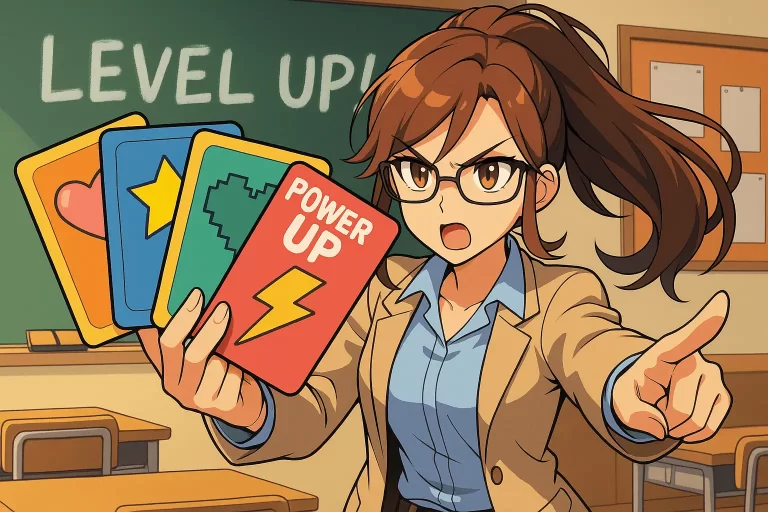Octalysis Framework Core Drive 2: Development and Accomplishment
Every student thrives on that feeling of success—whether it’s crushing a pop quiz or just remembering to bring a pencil two days in a row. It’s the fuel that powers motivation and builds confidence. But here’s the million-dollar question (cue dramatic game show music): how do you design a learning experience that makes students feel accomplished every single day?
Enter: Educational Gamification. The Octalysis Framework Core Drive 2: Development & Accomplishment is all about progress—the satisfaction of hitting milestones, earning rewards, and knowing that effort actually counts. And with the right kind of reward system, even your most reluctant learners will start leaning in, not checking out. Ready to see how to make school feel more like a side quest in Zelda (minus the dungeon crawling)? Let’s break it down.
This post is part of a series! Explore the entire Octalysis Framework and see how it can help you motivate your students. (Don’t let the FOMO pull you away, there is another link at the bottom of this post!)
Quest Map:
Breaking It Down
When we talk about Octalysis Framework Core Drive 2, we’re really asking: what makes your students want to keep going?
Spoiler: It’s not just about the prize at the finish line.
It’s about building a world where students feel like they’re leveling up, mastering skills, and getting that sweet, sweet sense of satisfaction. So how do we bring that to life in the classroom? Let’s look at practical ways to make this drive your classroom MVP.
And hey, if your students feel like the protagonist in their own learning journey (cue 80s training montage), you’re doing it right.

The Psychology of Progress
Imagine you’re in a race and the finish line keeps moving. Frustrating, right? That’s what it feels like for students who can’t see their own growth.
Progress—no matter how small—is crucial for motivation. The Octalysis Framework encourages rewarding the journey, not just the destination.
Celebrate everything: from finally mastering long division to raising a hand in class for the first time. Showcasing progress visually (think: digital leaderboards, badges, progress bars) turns invisible wins into public celebrations.
Don’t underestimate the dopamine rush from a progress bar inching forward. (We’ve all refreshed a loading screen just to watch it fill up.)
When students can actually see their improvement, it triggers a loop of positive reinforcement that keeps them hungry for what’s next.
Want to dig deeper into the psychology behind this? Explore The Octalysis Framework.
The Power of a Reward System
Let’s be real: we all work a little harder when there’s something fun on the line. (Yes, even grown adults will hustle for a coffee punch card.)
Gamification lets you build a whole ecosystem of rewards that speak your students’ language:
✨ Personalized badges for topic mastery
✨ Point systems that unlock real-world perks (extra recess, homework passes, class DJ privileges)
✨ Titles and levels like “Reading Rockstar” or “Science Sorcerer”
This isn’t bribery. It’s structured motivation. You’re giving students a clear path, a reason to care, and visible proof that they’re moving forward.
Rewards aren’t just stickers—they’re psychological nudges. And when those rewards tie back to effort, not just outcomes, students start building grit, too.
Curious about how it works in action? Peek into Learning Motivation via Gamification.

Making Learning Styles Count
One-size-fits-all? Said no teacher ever.
Not every student is driven by the same carrot. The cool thing about the Octalysis Framework is how well it adapts to different learning styles:
- Visual learners: Let them track progress with colorful dashboards or visual metaphors (like leveling up in a game).
- Kinesthetic learners: Design hands-on tasks as part of a mission (build a diorama, create a prototype, solve a puzzle).
- Social learners: Use group challenges or “guilds” where collaboration earns shared rewards.
- Reflective learners: Build in self-assessment milestones or reflection journals with badge systems.
It tells students: I see how YOU learn, and I built this for YOU. That message? It’s a game-changer.
Want a fun extra? Let students choose their own “player class” (a la RPGs) that reflects their learning style. Are they a Research Rogue? A Collaboration Cleric?
Check out the developer of Octalysis Framework Core Drive 2, Yu-kai Chou’s site for even more juicy insight into motivation and behavior design.
Practical Applications for K-12 Classrooms
Gamification isn’t just bells and whistles—it’s a framework that transforms how students experience success. Here’s how to make Octalysis Framework Core Drive 2 the main character in your classroom.
Gamified Achievement Systems
Leveling up isn’t just for video games.
- Try this: Students earn badges or complete progress bars as they finish lessons or projects.
- Weekly goals = mini rewards. A badge for finishing their reading log could earn line leader status or extra art time.
Pro Tip: Have a “Hall of Fame” bulletin board for achievement badges earned over the quarter. Instant morale boost.
Visible progress builds visible confidence.
Celebrate Achievements in Visible Ways
Humans love seeing their wins. (Just ask anyone who’s ever refreshed their Fitbit app.)
- Sticker charts, skill trees, milestone posters
- Let students decorate their own trackers—hello, ownership!
- Use classroom apps that let students unlock virtual accessories or pets for avatars
When students interact with their progress, it feels personal—and powerful.

Set Up Classroom Competitions
Friendly competition? Yes. Cutthroat Hunger Games vibes? Hard pass.
- Create quiz leagues or team missions. Make “math quest” or “grammar escape room” moments.
- Praise growth, not just high scores.
Competitions can also be themed. “Spelling Safari” or “History Hero Games” sound way cooler than “Friday Quiz.”
Students should compete against themselves, not each other.
Create Personal Milestones
Not every student starts at the same place. And that’s okay.
- Break goals into manageable pieces. Mastering one multiplication type at a time still counts.
- Quiet celebration matters. A sticky note that says “I see your progress” goes a long way.
- Include parents with occasional “home level-up” celebrations: “Look what Maria just unlocked in her writing journal!”
🧠 Octalysis Framework Core Drive 2: Development & Accomplishment – Game Techniques Cheat Sheet
|
Steps to Foster Development & Accomplishment in Education
Ready to weave Octalysis Framework Core Drive 2 into the everyday? Here are five go-to strategies:
1. Define Small, Manageable Goals
Big tasks can feel like boss battles. Break them down.
- Turn a research project into milestones: topic selection → resource collection → outline → draft.
- Each step = a tiny win that keeps momentum going.
Bonus idea: Turn goals into collectible “quest cards” for students to track.
2. Provide Immediate Feedback
Feedback shouldn’t feel like it’s arriving by carrier pigeon.
- In-the-moment praise, digital badges, or handwritten notes = real-time encouragement.
- Think: GPS recalculating your route, not a silent judgment zone.
Also: train peer feedback through “game master” roles, where students help others unlock progress.
3. Make Success Publicly Recognizable
Celebration creates community.
- Leaderboards, wall shoutouts, student of the week
- Recognize effort, not just results
- Host monthly “progress parties” to honor class wins (bonus: dance breaks encouraged)
4. Balance Stretch Goals with Accessibility
Challenge should motivate, not intimidate.
- Offer tiered challenges based on skill and comfort levels
- Let students pick their own path, then nudge them to stretch
- Include “epic boss levels” at the end of a unit for those who want a challenge
Need help fostering growth mindset? Here’s a great resource: Growth Mindset in the Classroom
Why Development & Accomplishment Matters
That sparkle in a student’s eyes when they “get it”? Priceless.
The Emotional Impact of Progress
Success builds self-worth. Without it, school feels like a treadmill with no “off” button.
Gamification makes progress visible, trackable, and emotionally satisfying.
It’s like switching from a foggy windshield to clear glass—students see their learning unfold.
Learn more from this insightful piece on learner engagement.
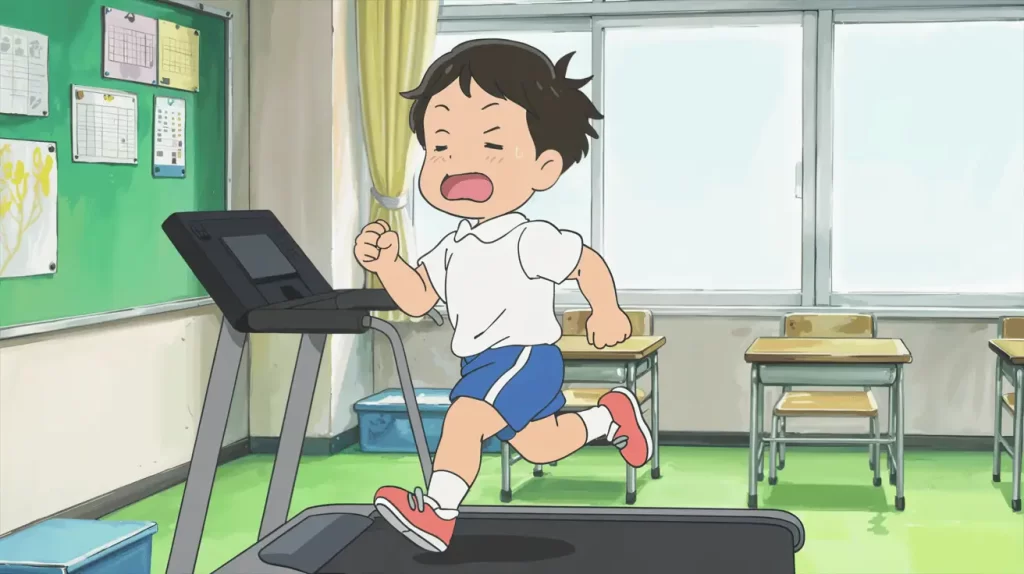
The Role of Achievement in Building Confidence
Accomplishment shows students: You did that. And you can do more.
- Tiered mastery levels
- Achievement-based feedback systems
Confidence isn’t built in a day—but every win stacks the bricks.
Check out The Benefits of Accomplishment-Based Education for more.
Encouraging Lifelong Motivation
Once students feel the joy of achievement, they want more. That’s the magic.
- Start with easy wins, then level up gradually
- Build systems that grow with them
And hey, isn’t that what we want as adults too? Growth that feels good?
Building Purpose Around Progress
Grades are fine. But the real win? Making growth feel personal.
- Use gamified reflection tools
- Give students ownership over what success looks like for them
- Let them craft their own “learning badge” by reflecting on challenges they’ve overcome
Making Accomplishment a Daily Reality
The most powerful shift in any classroom? Helping students say: “Look what I did.”
The Octalysis Framework Core Drive 2, paired with thoughtful Gamification, lets you build a classroom where every little win counts. And when kids start believing in themselves? That’s when the magic happens.
So ask yourself:
- Are you making success visible?
- Are students tracking their progress?
- Are you celebrating every step—not just the final test?
Add in personal reflection time, collaborative “what did we learn?” check-ins, and mini award ceremonies for the little wins. These things take minutes, but the confidence they build lasts for weeks.
And don’t worry—we’re just getting started. In the next post, we’ll unlock Ownership & Possession (Core Drive 4). Until then, join the email list for practical tools, nerdy gamification strategies, and ways to keep that sparkle alive in your students’ eyes. To see how all 8 Octalysis Framework Core Drives work together to skyrocket student motivation, take a look at this wider overview of the entire framework.
Because if anyone deserves a win today, it’s you and your students.
Want to explore more ways to motivate your students with Octalysis Framework?
Visit the Ultimate Guide to Octalysis Framework.
This comprehensive guide provides an overview of the entire framework and links out to more posts exactly like this one to guide you through all 8 Octalysis Framework Core Drives and even more!
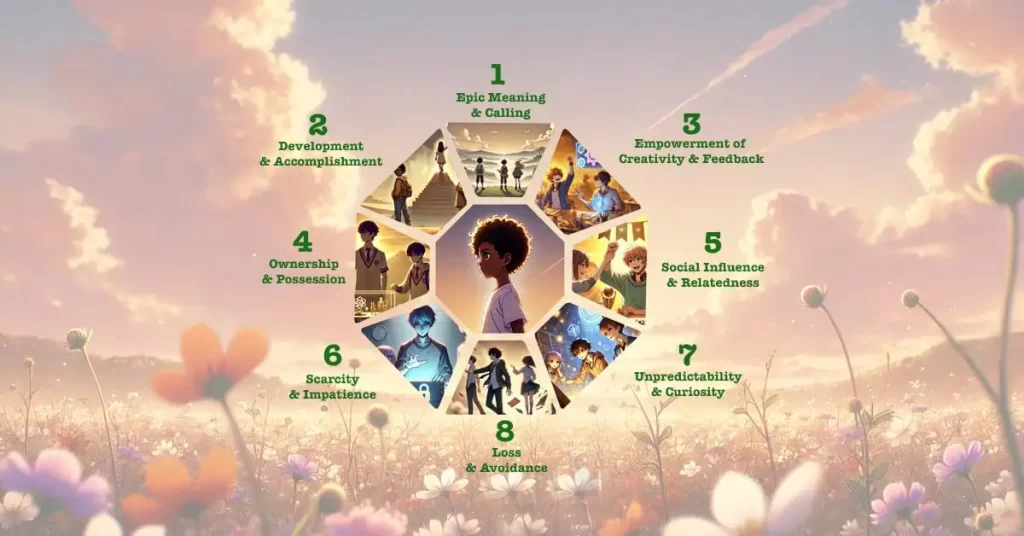
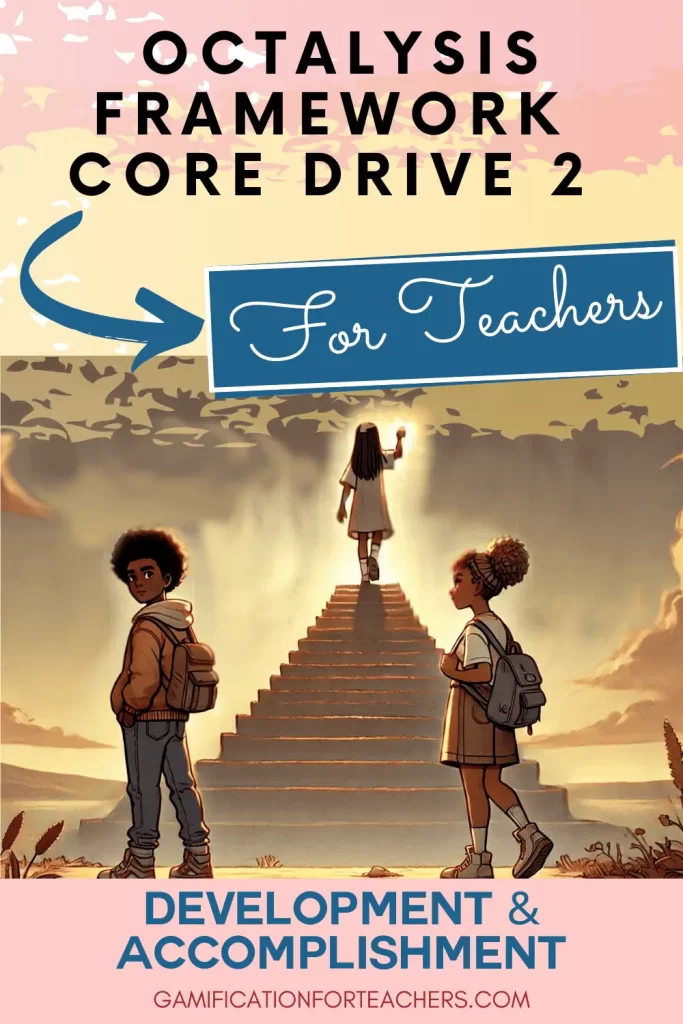
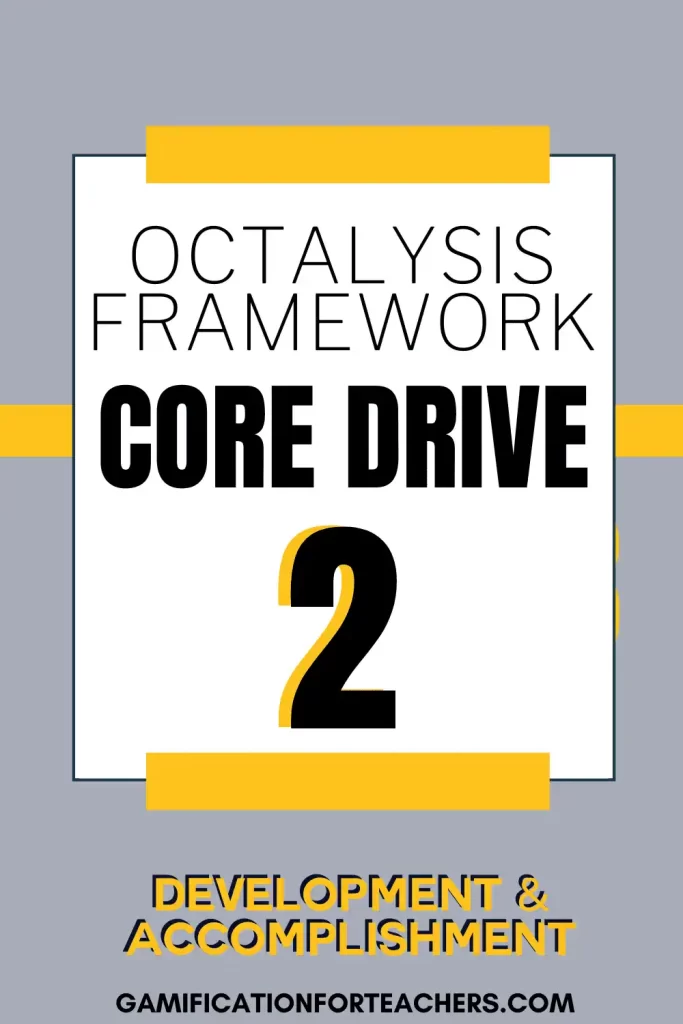

🎮 Octalysis Framework Core Drive 2: Development & Accomplishment FAQs
Isn’t giving points and badges just fluff?
Not if it reflects actual effort and growth. We all love progress bars — it’s why Duolingo has us out here learning Klingon at 2 a.m.
What if students start focusing on points more than learning?
Shift the spotlight to skill mastery rather than score-chasing. Think “Level up your persuasive writing” vs. “Get 500 XP.”
How do I make badges meaningful?
Give them clever, specific names tied to real effort (“Punctuation Pirate” > “Grammar Badge”) and let students display them publicly.
What’s a win state, and how do I use it?
A win state = “You did it!” moment. Think boss battles, end-of-mission ceremonies, or letting students narrate their learning journey.
How do I make sure Octalysis Framework Core Drive 3 helps every learner, not just the fast finishers?
Include mini-wins, streaks, and effort-based bonuses — not just completion-based ones. Let persistence shine too.






